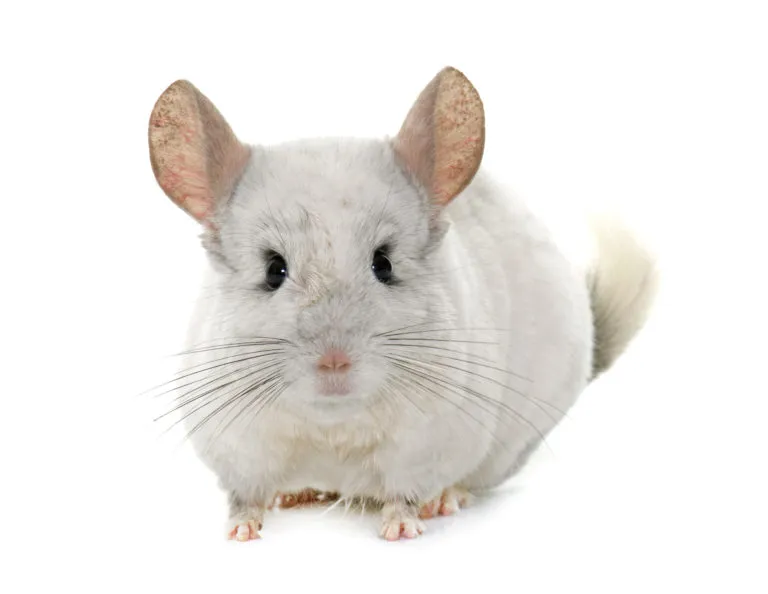Key facts
Weight: 1 – 1.5kg
Lifespan: 15-20 years
Indoor or Outdoor: Indoor
Domestic varieties include: Chinchilla lanigera, chinchilla brevicaudata.
All the way from South America
The small and cute chinchilla originally comes from South America. Thanks to its soft fur, its long ears and its bushy tail, people quickly fall for the charms of this small pet. Although Chinchillas are very furry, they are resistant to fleas and don’t lose much dander, which makes them hypoallergenic. Not all rodents are the same. If you are interested in having a chinchilla as a pet, you should research the food, care and habits of chinchillas before you bring one into your home in order to decide whether the specific needs and the behaviour of a chinchilla will match your wishes for a pet. With that in mind, it is important to know where they come from and how they live in the wild.
Species of chinchilla
There are two species of chinchilla: the short-tailed chinchilla and the long-tailed chinchilla. Any attempts to domesticate the short-tailed chinchilla have failed so all domestic chinchillas are descended from the long-tailed chinchilla. These creatures were originally found only in the barren Andes region in South America long before they were bred in Europe. The short-tailed chinchilla lives in the high up regions of the Andes at 3,500 to 4,500 meters above sea-level, while the long-tailed chinchilla lives at around 1,000 to 2,500 meters above sea-level.
Their natural habitat
The region of the Andes is dominated by a dry, desert-like climate with very little rainfall and low humidity. The chinchillas are exposed to greatly fluctuating temperatures there. They sleep during the day in crevices, caves, burrows or under thick undergrowth. Their mealtime is at dusk or during the night.
Due to their surroundings in the wild, their diet is naturally low in nutrients and high in fibre. In the wild these balls of fluff consume the roots of certain species of cactus as well as the fruit from cacti, seeds from certain shrubs, flowers and various types of grass. They get their intake of water from the morning dew on leaves and from the cacti.
Top tips for adopting a chinchilla
Chinchillas can be expensive pets, so make sure you know how much you need to spend on cages, accessories, food and vet’s fees before committing to buy. Remember that you will be looking after a chinchilla for up to 20 years. Always adopt from a reputable breeder, who will have spent time handling and socialising young chinchillas from birth, or you can also check your local animal shelter. Chinchillas like company, so it’s best to buy them in single-sex pairs. They can get stressed if they are left alone but may fight if kept in larger groups. Before buying your chinchillas, have the cage and equipment ready. Find a space for the cage in a quiet area of the house and make sure that it is away from radiators or draughts. Baby chinchillas are ready to leave mum at around 8-12 weeks of age. Be very careful if you suspect that the breeder or retailer you are buying from keeps the chinchillas in mixed-sex groups – you may be coming home with a pregnant female! Best to look elsewhere. Arrange a time to look at the chinchillas first and select your own from those available. Make sure you check the environment that the chinchillas are being kept in to ensure that none of them look ill (key signs are ruffled fur, runny eyes or nose or a dirty bottom) and that they are in clean and hygienic conditions. Watch how the chinchillas behave in the cage and in your hands – they should be calm and alert. Take a good look to check that they are healthy before agreeing to buy. They should be neither fat nor skinny with no swellings. The eyes and nose should be clear with no discharge and they should be breathing easily. The rear end should be clean, as should their coat, which should also be shiny, with no bare patches. Teeth should be well-aligned.
Settling in at home
All animals find moving house stressful and they will need time to adjust to their new surroundings. Chinchillas in particular are very sensitive to disruption and change. Put your chinchillas into the cage with all of the essentials like bedding, food and water, and allow them to settle in undisturbed over a couple of days. Trying to pick them up too soon can result in urine spraying or spitting – their natural defence mechanisms! Chinchillas respond well to routine, so try to feed them at the same time every day. Start quietly talking to them when you pass the cage and putting your hand into the cage to feed them treats. Take this stage slowly, so that they learn that you are not a threat. Eventually they will come to your hand for treats, and then you can think about letting them out of their cage for exercise. Remember that Chinchillas are not necessarily for cuddling. They may eventually start to climb over you and let themselves be stroked, but this takes time and careful handling.
The needs of chinchillas kept as pets
Before buying a chinchilla, potential owners should make sure that the cage is big enough for chinchillas which need lots of room to jump and climb around. Chinchillas need a sand bath every day in order to keep their fur clean and soft.
Seeing as chinchillas sleep during the day, it is very important that they have peaceful surroundings. The chinchilla cage should be placed near a window, but these pets shouldn’t be kept in direct sunlight or a draught.
Chinchillas are naturally nocturnal and tend to be timid so they are not suitable pets for children.
You can find chinchilla food and lots more in the zooplus shop!
